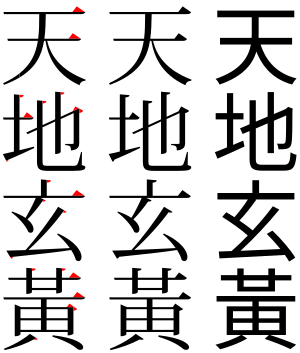Serif facts for kids
| Sans-serif font | |
 |
Serif font |
 |
Serif font (serifs in red) |
A serif is a term in typography. If a letter is made of a line or lines, a serif is a tiny decorative line on the ends of letter's 'limbs'. Thus, in the illustration on the right, each serif letter has a serif on the end of its lines.
Alphabetic typefaces either have serifs or not. Those without are called sans-serif faces.
The design of our typefaces started in the 15th century, when the early printers used moulds from which letters made of lead were produced.
The design of these letters were originally based on examples of handwriting and carving. Over the centuries a large number of typefaces were designed, and the serif/sans-serif feature is just one of many issues which type designers have to deal with.
However, the original source of the serif may be in monumental inscriptions. Serifs are on the letters at the base of Trajan's column (built 107~113 AD), and are clearly illustrated in standard textbooks on typography. Indeed, older literature often describes typefaces with serifs as "Roman". The word "serif" seems to be an early 19th century innovation.
Related pages
Images for kids
-
De Aetna, printed by Aldus Manutius
-
1611 book, with arabesque ornament border
-
Title page by John Baskerville, 1757
-
Memorial plaque by Eric Gill, c. 1920s
See also
 In Spanish: Gracia (tipografía) para niños
In Spanish: Gracia (tipografía) para niños





















